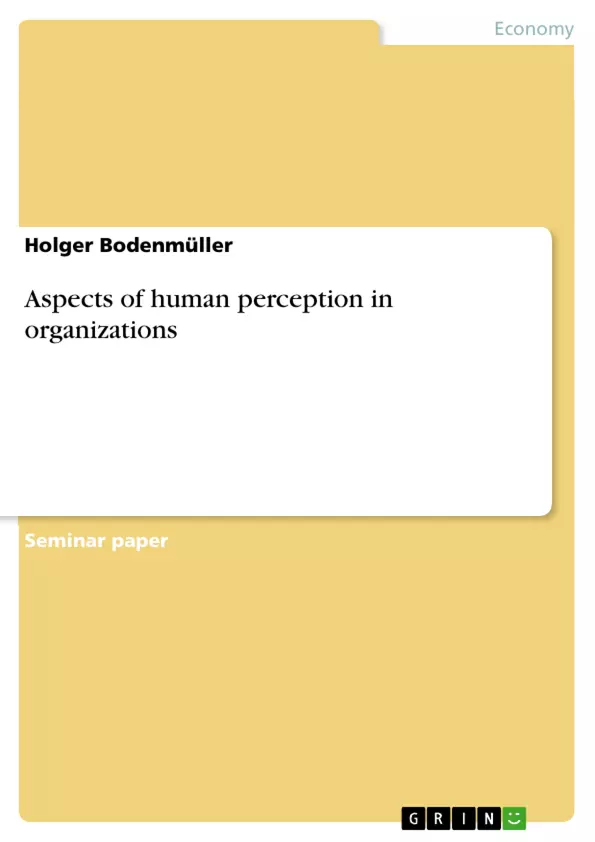Studying the nature of human perception has a long interdisciplinary history. From a constructivist perspective reality is a subjective interpretation of electrical signals transmitted via sensory tracts to the brain. Social perception has been the subject for intensive empirical research for the last 30 years. A lot of biases and effects have severe impacts on social interaction respectively the interaction between line leaders and their associates. Insights into the basic mechanisms of human/social perception may help to reflect mental models and improve decision making as well as the quality of giving feedback or practicing exploratory behaviour towards oneself and others.
Inhaltsverzeichnis (Table of Contents)
- Executive Summary
- Table of Contents
- List of Abbreviations
- List of Figures
- List of Tables
- Introduction/Problem Definition
- Objectives
- Methodology
- Main Part
- The Mind-Body Problem and the Self Reflecting Brain
- Perspectives of Radical and Social Constructivism
- Reducing Complexity: The Process of Selective Attention
- Social Perception: Biases and Effects with Impact on Social Interaction in Organizations
- Working with Mental Models: The Ladder of Inference
- Conclusion
- ITM Checklist
- Bibliography
Zielsetzung und Themenschwerpunkte (Objectives and Key Themes)
This text aims to explore the relationship between human perception and social interaction in organizations, particularly leadership behavior. It aims to answer questions about the cognitive aspects of perception and the influence of perception on social interaction. Key themes addressed include: * The nature of perception and its cognitive aspects * The concept of radical constructivism and its implications for reality * The role of selective attention in reducing complexity * Social perception biases and their effects on organizational interaction * Mental models and their application in leadership and decision-makingZusammenfassung der Kapitel (Chapter Summaries)
- Introduction/Problem Definition: This chapter introduces the concept of perception as a fundamental aspect of leadership and social influence. It highlights the importance of understanding perception from both neurophysiological and cognitive perspectives.
- Objectives: This chapter outlines the main objectives of the text, focusing on exploring the connection between human perception and social interaction, particularly in organizational leadership.
- Methodology: This chapter discusses the methodological approach employed in the text, providing context for the research and analysis presented.
- The Mind-Body Problem and the Self Reflecting Brain: This chapter delves into the philosophical debate surrounding the relationship between the mind and body, examining the role of the brain in perception and its implications for understanding human consciousness.
- Perspectives of Radical and Social Constructivism: This chapter explores the theories of radical and social constructivism, examining how these perspectives challenge traditional notions of objective reality and emphasize the subjective nature of perception.
- Reducing Complexity: The Process of Selective Attention: This chapter examines the role of selective attention in managing information overload and simplifying complex situations. It explores the cognitive mechanisms involved in focusing attention and filtering out irrelevant information.
- Social Perception: Biases and Effects with Impact on Social Interaction in Organizations: This chapter investigates various biases and effects that influence social perception, highlighting their impact on interactions within organizations. It explores how these biases can affect leadership behavior and decision-making.
- Working with Mental Models: The Ladder of Inference: This chapter introduces the concept of mental models and their role in shaping our understanding of the world. It explores the "ladder of inference" framework as a tool for analyzing and improving decision-making processes.
Schlüsselwörter (Keywords)
Key concepts explored in this text include human perception, social interaction, leadership behavior, radical constructivism, selective attention, social perception biases, mental models, and the ladder of inference. These concepts provide a framework for understanding how perception shapes our understanding of reality, influences our interactions with others, and impacts organizational dynamics.- Quote paper
- Holger Bodenmüller (Author), 2011, Aspects of human perception in organizations, Munich, GRIN Verlag, https://www.grin.com/document/271650



